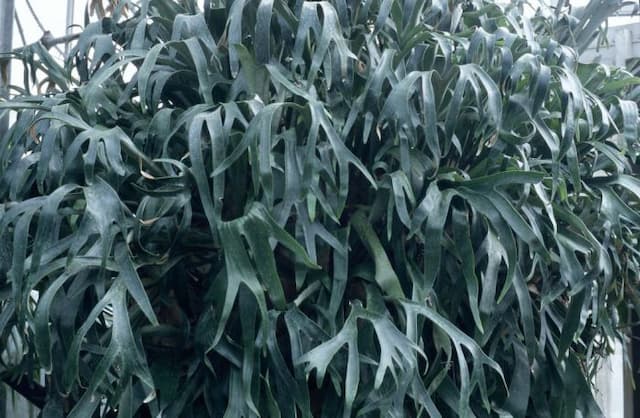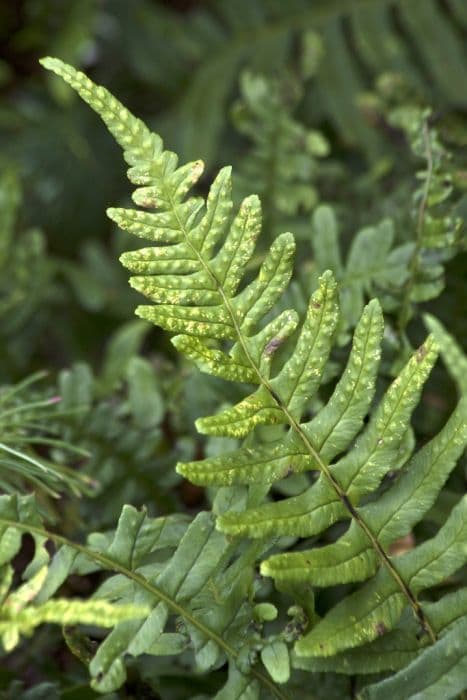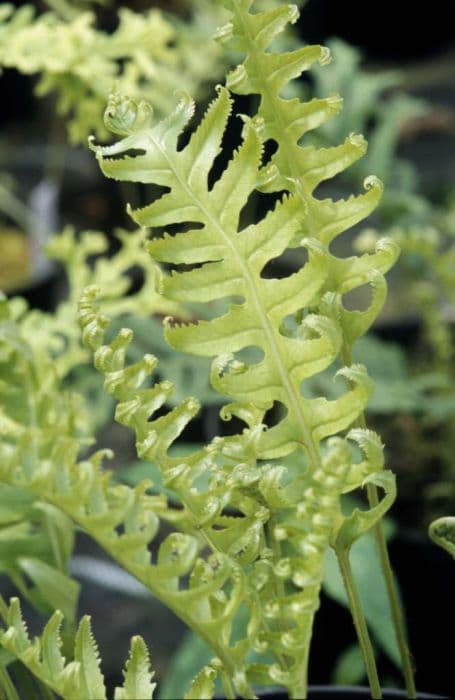Crested Polypody Polypodium cambricum (Cristatum Group) 'Grandiceps Fox'

ABOUT
The plant commonly known as "Grandiceps Fox" fern features uniquely shaped fronds with a verdant green color, giving it a distinctive appearance. The fronds usually have a wavy or crinkly texture, appearing almost like they have been carefully cut into fanciful shapes. This elaborate frond architecture leads to a whimsical and textured look, which is enhanced by the way the tips of the fronds have divided, creating a crested or comb-like effect that is quite ornamental. The individual leaflets, or pinnae, are also irregular, contributing to the plant's overall lush and ruffled look. They are somewhat elongated and narrowed, often curled or twisted, which creates a sense of motion within each frond. The overall effect of these characteristics is a delicate and intricate appearance often sought after by gardeners and plant enthusiasts for its visual interest and the elegant touch it can add to a shaded garden space or a plant collection. It's a type of fern that offers a soft, feathery texture to landscapes or indoor environments, with a leaf pattern that can catch the eye and hold attention, making it a favorite among those who enjoy ornamental foliage.
About this plant
 Names
NamesFamily
Polypodiaceae
Synonyms
Crested Polypody, Crested Prickly Shield Fern, Grandiceps Fox Polypody
Common names
Polypodium cambricum 'Grandiceps', Polypodium vulgare var. cambricum Cristatum Group 'Grandiceps Fox'.
 Toxicity
ToxicityTo humans
The Southern Polypody, which is the common name for Polypodium cambricum, is not commonly known for being toxic to humans. There are no well-documented cases of poisoning or specific symptoms associated with ingestion of this fern by humans. It is generally considered safe, but it is not advisable to consume any part of ornamental plants due to potential individual allergies or gastrointestinal discomfort.
To pets
Similar to its effects on humans, the Southern Polypody is not known to be toxic to pets. There are no specific symptoms or reports of poisoning in pets due to ingestion of this fern. However, as with any non-food plant, it is still prudent to prevent pets from ingesting it to avoid any potential but unlikely gastrointestinal upset.
 Characteristics
CharacteristicsLife cycle
Perennials
Foliage type
Evergreen
Color of leaves
Green
Height
1 feet (0.3 meters)
Spread
2 feet (0.6 meters)
Plant type
Fern
Hardiness zones
5-10
Native area
Europe
Benefits
 General Benefits
General Benefits- Aesthetic Appeal: Adds unique texture and shape to gardens with its unusual, crested fronds.
- Low Maintenance: Requires minimal care once established, making it suitable for busy gardeners.
- Shade Tolerant: Thrives in shaded areas where other plants might struggle to grow.
- Drought Resistant: Can survive dry spells, reducing the need for frequent watering.
- Cold Hardy: Capable of withstanding cooler temperatures, suitable for a variety of climates.
- Evergreen: Provides year-round greenery and interest in the garden landscape.
- Versatility: Suitable for planting in containers, rockeries, or as ground cover under larger plants.
- Habitat Support: Offers shelter and potential food sources for insects and small wildlife.
 Medical Properties
Medical PropertiesThis plant is not used for medical purposes.
 Air-purifying Qualities
Air-purifying QualitiesThis plant is not specifically known for air purifying qualities.
 Other Uses
Other Uses- Polypodium vulgare 'Grandiceps', commonly known as the Crested Buckler Fern, can be used in terrariums or bottle gardens due to its moderate size and tolerance of humidity.
- Crested Buckler Fern spores can be used for propagation in teaching students or enthusiasts about the life cycle of ferns.
- The plant can serve as a subject in botanical illustration classes because of its unique crested fronds that provide a compelling and intricate subject.
- In large-scale gardens, Crested Buckler Fern can be used as part of a 'living wall', where its lush foliage provides a refreshing green backdrop.
- As a natural dye, the fern can contribute to eco-friendly textile dyeing projects, potentially yielding a variety of green hues.
- Crested Buckler Fern can play a role in fantasy or prehistoric-themed gardens, due to its ancient lineage and primordial appearance.
- The fern can be used for floral arrangements, with its fronds adding texture and greenery to bouquets or as a backdrop for other flowers.
- It can be used in performance art or set design, providing a vibrant and natural-looking element in costumes or on stage sets.
- In the culinary world, Crested Buckler Fern's fronds could be used as a natural garnish for presenting or plating dishes, although they are not edible.
- For horticultural therapy, this fern can be used as a tactile plant because the unusual shape and texture of its fronds can stimulate sensory engagement.
Interesting Facts
 Feng Shui
Feng ShuiThe Lemon Button Fern is not used in Feng Shui practice.
 Zodiac Sign Compitability
Zodiac Sign CompitabilityThe Lemon Button Fern is not used in astrology practice.
 Plant Symbolism
Plant Symbolism- Longevity: As a type of fern, Polypodium cambricum, commonly known as the Welsh polypody, is often associated with longevity due to its ability to thrive in various conditions and its evergreen nature.
- Health: Ferns like the Welsh polypody have been used for their medicinal properties historically, and so they can symbolize health and wellness.
- Endurance: The Welsh polypody can survive in shaded forest floors and grow on other surfaces as an epiphyte, which suggests resilience and the ability to endure challenging situations.
- Protection: In some cultures, ferns are believed to ward off evil spirits and negativity, representing protection and safety.
- Secret Bond of Love: Victorians associated ferns like the Welsh polypody with secret love and clandestine messages. In the language of flowers, ferns sometimes symbolized a secret bond of love.
- Magical Properties: Among the many mystical attributes, ferns are thought to have magic powers, including the ability to see into the future, find hidden treasures, or gain the protection of the fae.
 Water
WaterPolypodium, commonly known as the polypody, should be watered when the top inch of soil feels dry to the touch. Water the plant thoroughly until excess water drains out of the bottom of the pot, indicating that the roots have received ample moisture. Depending on the humidity and temperature of its environment, a polypody may need water roughly once every 7 to 10 days. During the winter, reduce the frequency of watering as the plant's growth slows down. When watering, use about half a gallon of water to thoroughly saturate the soil, adjust the amount based on the pot size and the plant's response.
 Light
LightPolypody thrives in bright, indirect light, making a spot near a window that receives filtered sunlight ideal. Avoid direct sunlight as it can scorch the leaves, but ensure there's enough light to maintain its vibrant green foliage. If you notice the plant stretching towards the light, it may not be receiving enough, so adjust its position accordingly.
 Temperature
TemperaturePolypodys prefer a temperature range between 50°F and 75°F. They can survive brief periods outside of this range, with a minimum temperature tolerance of around 40°F and maximum of 80°F, but for healthy growth, aim to maintain a consistent temperature within the ideal range. Avoid placing your polypody near drafts, heating vents, or air conditioners as sudden temperature changes can harm the plant.
 Pruning
PruningPruning a polypody is mostly to remove any dead or yellowing fronds to encourage healthy growth and maintain its aesthetic appeal. It's best to prune in the spring or early summer when the plant is actively growing. Using sharp scissors or pruning shears, cut the fronds at the base where they meet the soil, and prune sparingly – only as needed to shape the plant or to remove unhealthy fronds.
 Cleaning
CleaningAs needed
 Soil
SoilThe Welsh Polypody prefers a mix that mimics its natural woodland habitat; fertile, well-drained, and high in organic matter with a pH ranging from neutral to slightly acidic. A mix of loam, peat, and sharp sand would create an ideal environment for growth.
 Repotting
RepottingThe Welsh Polypody should be repotted only when necessary, typically every 2 to 3 years, to refresh the soil and accommodate root growth, being cautious not to disturb the roots excessively.
 Humidity & Misting
Humidity & MistingThe Welsh Polypody thrives in moderate to high humidity levels, ideally around 60% to 70%, which helps to maintain its lush, green fronds.
 Suitable locations
Suitable locationsIndoor
Provide dappled light, moist soil, and mist foliage regularly.
Outdoor
Position in partial shade; ensure soil is humus-rich, moist.
Hardiness zone
6-10 USDA
 Life cycle
Life cycleThe life of the Polypodium cambricum, commonly known as Southern Polypody, begins with spore germination. These spores, released from mature plants, develop into a gametophyte, a heart-shaped thallus that hosts the reproductive organs. The gametophyte stage is crucial for sexual reproduction, during which it produces sperm and eggs that fuse to form a new diploid zygote. This zygote ultimately grows into a sporophyte, the leafy fern we recognize, which is the dominant phase of the plant's life cycle. As the fern matures, it develops distinctive fronds that uncurl from fiddleheads. Over time, the fronds produce sporangia clusters, known as sori, on their undersides, completing the cycle as these sori release new spores to propagate the species.
 Propogation
PropogationPropogation time
Spring to Summer
Propogation: The Polypodium cambricum, commonly known as the Welsh Polypody, is traditionally propagated through spores, which is the most popular method for many ferns. Propagation time usually coincides with when the spores are mature, which typically occurs in late summer. To propagate by spores, collect ripe spores from the undersides of the fronds when they're dry and brown. Sow the spores on the surface of a sterilized, damp, peat-based seed compost in a pot or shallow tray. The container should be covered with a lid or plastic wrap to maintain humidity and placed in indirect light at a temperature around 68 degrees Fahrenheit (20 degrees Celsius). Germination can take several weeks to months; once the sporelings (young ferns) are large enough to handle, they can be carefully pricked out into individual pots filled with suitable potting mix to grow on.



